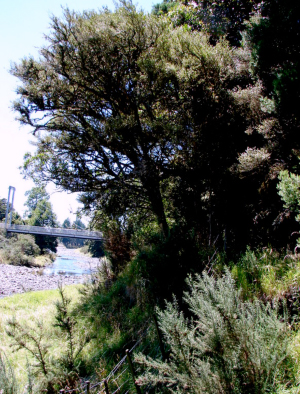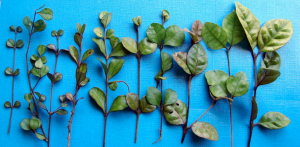Lophomyrtus ×ralphii
– Cockayne’s natural Taranaki hybrid
Scientific
name: Lophomyrtus ×ralphii (Lophomyrtus
from the Greek meaning crested myrtle, ralphii
after Doctor Thomas Shearman Ralph [1813 -1891] who collected specimens of the
plant for naturalist J. D. Hooker [1817-1911] near the city of Wellington)
Common Name:
Small-leaved ramarama
Family name: Myrtaceae
The complex
history surrounding the recognition of this natural wild hybrid has a strong
connection with several of New Zealand’s most notable botanists and with the
Meeting of the Waters reserve in Taranaki.
Myrtus is the former name for a small group of shrubs and small trees two of
which eventually became reclassified under the genus Lophomyrtus. When listed by T. Kirk (1889) in The Forest Flora of New Zealand and subsequently by T. F. Cheeseman
(1925) in the Manual of New Zealand Flora
the plant in question was considered a distinct species Myrtus ralphii, having been first described by J. D. Hooker (1835).
Myrtus ralphii as it was known then was described as an erect
branching shrub of about 2 metres or more, sometimes becoming a small tree. It was
considered closely allied to Myrtus
bullata or ramarama but with smaller leaves and with fewer-seeded berries.
Ramarama is an erect shrub or small tree reaching 8 metres with green to reddish
brown ovate foliage up to 3 cm long that has a distinctive blistered appearance.
The other species
in this former genus, Myrtus obcordata
or rohutu is a more slender branching shrub or small tree of up to 5 m with much
smaller and obcordate (inversely heart-shaped
) leaves, up to 1cm long, about one third the size of the ramarama leaves, and
with berries (4-8 mm diameter), about half size of ramarama.
By the time the
first volume of the Flora of New Zealand
was published there was no species with the epithet ralphii listed. There were in fact only the two species recorded in
this volume under the new genus name separated from Myrtus, these being Lophomyrtus
bullata, ramarama and Lophomyrtus
obcordata, rohutu. Allan (1961) noted under the heading ‘Hybridism’ (p.
330) that what was previously known as ‘Myrtus ralphi’ was in fact a hybrid (M. bullata × M. obcordata).
It was field work undertaken by another eminent botanist and ecologist,
Leonard Cockayne (1918) that first led to the proposal that Myrtus ralphii was a hybrid between
ramarama and rohutu. It is also at this point that the particular connection is
made with Taranaki.
Cockayne
examined many specimens from near Wellington and New Plymouth, or more
precisely from the Meeting of the Waters Scenic Reserve just south of New
Plymouth, along with specimens from the East Coast collected by William Colenso
(botanist and missionary 1811-1899). He concluded that the specimens previously
placed under M. ralphii were in fact of
hybrid origin (M. bullata × M. obcordata). Cockayne supported his hypothesis
with a description of the natural distribution of the two species in relation
to the occurrence of M. ralphii and
demonstrated that in the field a polymorphic series of intermediary forms or hybrids
were usually found where both the parents met or were common. Cockayne sent
specimens to Cheeseman who initially would only concede that it gave a certain
amount of support to the view that it might be a hybrid but gave an example
where he believed the ‘species’ M.
ralphii occurred yet both the ‘parents’ were absent.
Botanical
history records this debate resolved in favour of Cockayne’s proposition. Allan (Genetica
11, 1929, 491) concurred with Cockayne illustrating some of the many forms
found in a forest remnant near Feilding, where both
parents were common. Also seedlings raised from an intermediate form were shown
to produce a complete range from nearly pure ‘obcordata’ to nearly pure ‘bullata’, with several forms that matched the
original M. ralphii specimens.
The Taranaki connection
was cemented when Cockayne (1918) described how upon seeing the range of forms
present at the Meeting of the Waters, he realized for the first time that ‘ralphii’ may in fact be a hybrid:
“At the Meeting
of the Waters, near New Plymouth, there not in a wind-swept habitat, but in the
moist, still atmosphere of the forest-interior, I saw an astonishing series of
intermediates between M. bullata and M. obcordata present. It was seeing
these plants, indeed, which first suggested the theory of hybrid origin, and
which led me to carefully examine the plants of the Wellington wind-scrub.”
Cockayne was
later sent sixty one individual plant specimens
collected from the Meeting of the Waters by R. H. Rockwell which he used in his
analysis. Cockayne commented in
regard to the those specimens that “a casual glance at the collection shows
that my former word ‘astonishing’ used with regarded to the polymorphy of Myrtus ralphii in that locality (Meeting
of the Waters) is no exaggeration.” Incidentally, Cockayne (1915) had also
previously noted an abundance of the parasitic Dactylanthus taylorii, or wood rose, had been observed at the
reserve, “the plants extended thickly over an area of more than one acre”;
unfortunately none has been found here in recent times.
On visiting the
Meeting of the Waters today you can still find both the Lophomyrtus parents and intermediate ‘polymorphic’ variations that
Cockayne described. They are generally easily located near and on both sides of
the Waiwhakaiho River and in the adjacent remnant forest, and particularly at
the eastern end of the reserve. The variation in leaf colour, size and
appearance is indeed remarkable; a feature of hybridization that has been well exploited
commercially throughout the country with a wide range of nursery bred, selected
and named cultivars that derive from the same parental stock. The former New
Plymouth nursery Duncan Davies for example released cultivars with such names
as ‘Indian Chief’, ‘Katherine’, ‘Purpurea’, ‘Technicolor’, ‘Sundae’ and the
like, each with some distinct colour or character but all deriving one way or the
other from Lophomyrtus hybrids.
The Meeting of
Waters Scenic Reserve is a popular recreational area for picnics, swimming and canoeing.
It is also known for the fine example of podocarp/broadleaf forest, numerous
emergent conifers (matai, rimu, totara, miro and kahikatea), the best matai
regeneration of all West Taranaki Reserves, and a habitat conducive to and
populated by many native epiphytic orchid species. But not so widely known is
the reserve’s significance in New Zealand botanical history linked to the
occurrence of the hybrid swarm between L.
bullata and L. obcordata. When
next you visit this fascinating place, remember that the great ecologist and
author of New Zealand Plants and Their
Story (1910), renowned for his extensive botanizing, pioneer ecological work
and field explorations throughout the country, has also walked alongside these
waters.
Photos

Meeting of the Waters Scenic Reserve with Waiwhakaiho River bridge

A hybrid swarm: L. obcordata (left) and L. bullata (right) from the Meeting of the Waters
Plant List